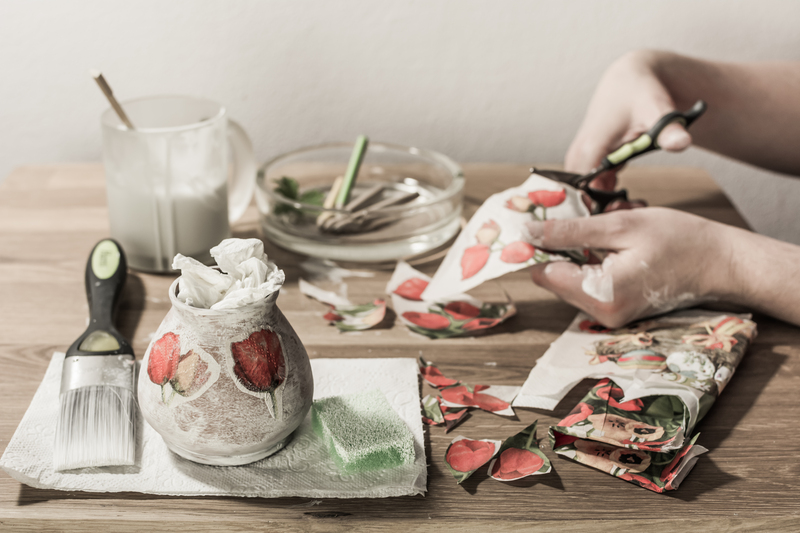The Art of Recycling Kitchen Pots and Pans: A Comprehensive Guide
Recycling kitchen pots and pans has become an essential conversation in today's environmentally conscious world. Most households eventually have to deal with old cookware, but few people realize just how much impact and opportunity lies in the proper recycling and upcycling of old pots and pans. Uncover the fascinating world of transforming your old cookware and discover how recycling these common kitchen items can help contribute to a healthier planet, a thrifty lifestyle, and a clutter-free home.

Why Should You Recycle Your Kitchen Pots and Pans?
The average person uses dozens of pots, pans, and cooking utensils throughout their lifetime. As these items reach the end of their practical use--whether due to damage, wear, or simply upgrading to a new set--they often wind up in landfills, contributing to growing waste concerns. The environmental benefits of recycling cookware are significant:
- Reduces landfill waste: Metal and non-stick pans don’t decompose easily. Recycling keeps them out of landfills.
- Conserves resources: Repurposing the metals and materials found in pans conserves natural resources.
- Cuts energy use: Recycling old cookware uses far less energy than mining and refining new materials.
- Saves money: Upcycling pots and pans can be a creative way to save cash and reduce your household expenses.
Environmental Impact of Disposing Pots and Pans
Kitchen cookware is often made from metals such as aluminum, stainless steel, copper, and cast iron--materials that are highly recyclable. However, when not disposed of properly, these materials can pose environmental risks. For example, Teflon-coated pans (non-stick cookware) may contain chemicals that can leach into soil and water if left in a landfill. Recycling kitchen pots and pans responsibly helps to minimize these risks and supports a sustainable ecosystem.
How to Recycle Kitchen Pots and Pans: Practical Steps
Recycling pots and pans isn't as straightforward as tossing them into your curbside bin. Here's a step-by-step approach to ensure your old cookware is handled in an eco-friendly way:
1. Identify the Material
- Stainless steel, aluminum, copper, and cast iron are all recyclable metals, but they may need to be separated by type for proper processing.
- Check if your cookware has mixed materials, such as plastic handles or glass lids, which may complicate recycling.
2. Remove Non-recyclable Parts
Some pots and pans come with wooden, plastic, or silicone handles. Remove these components if possible to make the metal more valuable for recycling. If the handles cannot be removed, contact your local recycling center to ask if they can process mixed-material cookware.
3. Clean the Cookware
Rinse off any food residue and scrub off grease. Though heavy scouring isn't required, clean cookware is easier to process, and some scrap yards may reject items with too much debris.
4. Find a Local Scrap Metal Recycler
Curbside recycling programs often do not accept bulky items like pans, but scrap metal recycling centers do. Search for local recycling centers that accept household metals. Call ahead to ensure they're able to process your specific items.
5. Understand Non-stick Cookware Challenges
Recycling non-stick pans (like those coated with Teflon) is more complicated because facilities may not accept them due to the chemical coatings. Look for specialized recycling programs or contact manufacturers, as some offer take-back programs for old pans. Remove as much non-metal material as possible before recycling.
Alternative Ways to Recycle and Reuse Kitchen Cookware
While traditional recycling routes are ideal, sometimes your old cookware can gain a new life beyond the kitchen. Here's how you can upcycle and repurpose kitchen pots and pans for creative, practical, or decorative purposes:
1. Garden and Planter Projects
Transform your old pots and pans into quirky and functional planters. Metal pots provide excellent drainage and add a rustic charm to any garden space. Simply drill some holes in the bottom for water drainage, fill with soil, and plant your favorite flowers or herbs.
- Hanging planters: Attach sturdy ropes or chains to convert old frying pans into unique hanging gardens.
- Mini herb garden: Smaller saucepans make ideal herb pots for kitchen windowsills or balconies.
2. Artistic and Decorative Uses
Unleash your inner artist by turning old cookware into wall art or creative home decor:
- Wall clocks: Repurpose a round pan into a clock by adding a simple mechanism and decorating the face.
- Mosaic backgrounds: Use lids as unique canvas bases for mosaics or paintings.
- Garden sculptures: Weld together pots and pans to create fascinating metal sculptures for your backyard.
3. Organization Solutions
Give your home a functional twist by recycling old pans into organizers:
- Utensil holders: Deep pots can be used to store spatulas, spoons, and other kitchen tools.
- Desk organizers: Small pans and lids work perfectly for desk storage, such as for pens, pins, or stationery.
4. Charitable Donations
If your cookware is still in usable condition, consider donating it to local shelters, food banks, or community centers. Many organizations welcome gently used pots and pans for their communal kitchens.
Manufacturer and Retailer Take-Back Programs
Some cookware brands and retailers are recognizing the importance of sustainability and now offer take-back and recycling programs for old pots and pans. These initiatives allow customers to return used cookware for responsible recycling or proper disposal. Notable examples include:
- TerraCycle: Partners with several brands to recycle hard-to-process cookware items.
- The Home Depot or Lowe’s: Occasionally host community recycling events where cookware is accepted alongside other household items.
- Brand-specific take-back: Companies like Calphalon, Le Creuset, and GreenPan may offer recycling or trade-in options; check their websites or contact customer service for details.
When purchasing new cookware, consider brands with established recycling programs or made from sustainably sourced materials.
Proper Disposal Methods for Damaged or Non-Recyclable Cookware
In some cases, pots and pans are simply too damaged or contain hazardous materials (like lead or PFOA) that make recycling or reuse impractical. For these items:
- Check local hazardous waste guidelines on how to handle cookware containing dangerous materials.
- Contact your local waste authority to ask about safe disposal options.
- Avoid disposing in regular trash if the cookware poses any chemical risk.
The Lifecycle of Recycled Cookware Metals
Ever wondered what happens after you recycle your stainless steel pan or aluminum pot? The art of recycling kitchen pots and pans continues well beyond your local recycler. Here's the general process:
- Collection and sorting: Metal cookware is gathered and sorted by type at the recycling facility.
- Cleaning and preparation: Items are cleaned to remove any residual food, coatings, or non-metal parts.
- Shredding and smelting: The metal is shredded, melted in a furnace, and purified.
- Remanufacturing: Recycled metal is formed into new products--sometimes even new cookware--creating a circular lifecycle for the material.
Tips to Make Your Cookware Last Longer
One of the best ways to practice sustainability is to extend the life of your kitchen cookware before recycling them. Here are a few tips:
- Avoid metal utensils with non-stick surfaces to prevent scratching.
- Hand wash when possible instead of relying on dishwashers, which can be harsh on certain materials.
- Regular seasoning: Keep cast iron and carbon steel pans seasoned to enhance durability.
- Proper storage: Avoid stacking heavy items to prevent dents or distortions.
By caring for your pots and pans, you can delay the recycling process and minimize waste.

Innovations and Trends in Recycling Kitchen Pots and Pans
The future of recycling kitchen cookware is bright and constantly evolving. Here are some modern trends and innovations:
- Sustainable design: Cookware brands are increasingly designing products with recycling in mind, using single-material construction for easier processing.
- Return-and-recycle incentives: More retailers are offering discounts or credits in exchange for old pots and pans.
- Zero-waste kitchens: The movement toward zero-waste living encourages consumers to buy durable, long-lasting kitchenware and manage end-of-life disposal responsibly.
- Community repair events: Repair cafes and workshops teach people how to fix rather than discard damaged cookware.
Conclusion: Embracing the Art of Kitchen Cookware Recycling
The art of recycling kitchen pots and pans is about more than just environmental responsibility; it's about creativity, resourcefulness, and thoughtful consumption. Whether you donate, upcycle, or recycle your old cookware, your actions make a difference. By embracing sustainable solutions to kitchen waste, you contribute to a cleaner planet, inspire others to think green, and might even find some unexpected joys in transforming what could have been trash into treasured new items for your home or garden.
Remember, every stainless steel pan recycled, every cast iron skillet repurposed, and every non-stick pot properly disposed of helps pave the way for a more sustainable culinary future. Make the smart choice with your kitchen cookware--and become part of the art of recycling today!